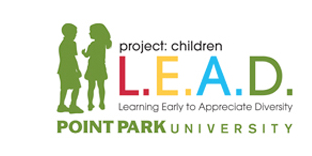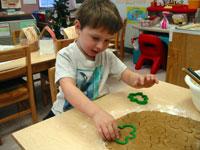Lesson 12: Kindergarten (Ages 5-6) Foods and Language Lesson Series

Project: LEAD | Curriculum | Resources | Workshops | Activities | About Us
Foods and Languages of the World
Teacher: Eleanor Vistein
Project Children L.E.A.D. Director: Dr. Vincenne Revilla Beltran
Subject Area: Diversity
Grade level: Kindergarten (Ages 5-6)
Length of Lesson: 60 minutes
Learning goals based on Pennsylvania Academic Standards, N.A.E.Y.C. or Early Childhood Learning Continuum Indicators: Children are provided varied opportunities and materials to build their understanding of diversity in culture, family structure, ability, language, age, and gender in non-stereotypical ways.
Arts and Humanities
9.1. E. Demonstrate the ability to define objects, express emotions, illustrate an action or relate an experience through creation of works in the art.
Geography
7.1. A. Identify geographic tools and their uses
-
Globe
-
Map
Language Arts
1.2. A. Recall content of informational texts
1.6. A. Listen to a selection of literature
Math
2.1. A. Count using whole numbers.
2.3. E. Identify different units of measurement.
2.4. B. Identify the use of measurement in everyday situations.
OBJECTIVES: After listening to the story, the students will be able to name some of the ways that children in various neighborhoods get to school. The students will be able to locate North America on a globe and a map. The students will identify measuring cups and spoons as a necessary tool to make cookies. The students will make and decorate cookies from around the world.
MATERIALS AND EQUIPMENT NEEDED:
-
Books:
-
Baer, Edith. This is the Way We Go to School, a Book about Children around the World. Scholastic, 1990. ISBN: 0-590-43162-5
-
Wilson, Dede. A Baker's Field Guide to Christmas Cookies. The Harvard Common Press, 2003. ISBN: 1-55832-263-9
-
-
Record
-
Macmillan Sing and Learn Series. Greetings World. On Our Earth.
-
-
Record player
-
Map
-
Globe
-
Measuring cups and spoons
-
Bowls, wooden spoons, and spatulas
-
Electric hand mixer
-
Baking trays
-
Parchment paper
-
Oven
-
Check individual recipes for other utensils needed
-
Check individual recipes for ingredients needed
ADAPTATIONS AND ACCOMMODATIONS TO DIFFERENTIATE INSTRUCTION:
The recipe book used in this lesson is for Christmas cookies, but because the country of origin of each cookie is listed along with the recipe, I was able to use the recipes as an introduction to cookies from around the world. Choose recipes that you think will be successful and appropriate for the children. Some of the children may need one-on-one instruction with the measuring. An adult needs to do the actual baking because of safety issues involved with the oven.
PROCEDURES:
REVIEW: The children had a lesson on families and neighborhoods prior to this lesson; ask the children to name some similarities and differences of their families and neighborhoods. Remind the children that we learned that some of their families eat different food than other families. We also learned that how we get to school from our neighborhoods varied; some of us ride a bus and some of us ride in a car.
INTRODUCE: Today, we are going to learn about some children in neighborhoods in other parts of the world. We will learn about how they get to school, how they say "hello," and what cookie in our cookie book originated in their country.
DEVELOP:
-
Read the book, This is the Way We Go to School, a Book about Children around the World, as a springboard into the lesson.
-
Ask the children to share some of the ways the children in the book go to school.
-
Revisit the book. Tell the children some of the countries represented in the book: these are listed in the back of the book.
-
Several pages represent children from North America. Choose one of these pages to revisit with the children. Tell them we also live in North America.
-
Show the children the globe. Tell them the globe is a way to locate the various countries.
-
Show them North America on the globe.
-
Have several children take turns choosing a page in the book. Review the mode of transportation illustrated in the book, and show the children where that country is located on the globe in relationship to North America.
-
Show the children the map in the back of the book. Explain that a map is similar to a globe except that it is flat.
-
Ask for a volunteer to locate North America. Give assistance if necessary.
-
Tell the children that not all people in North America say "hello" the same way we do.
-
Show children Mexico which is part of North America.
-
Ask if anyone knows how the children in Mexico say "hello."
-
Tell the children that children in Mexico say "hola."
-
Tell the children that we are going to participate in a song that will teach us how children in Spain, Kenya, Japan, and Israel say "hello."
-
Play the recording, "Greetings World!" for the children to participate in a "call and response" song.
-
Revisit the map in the back of the book. Ask for a volunteer to once again show North America.
-
Show children Canada which is part of North America. Tell them we are going to make cookies from Canada and the United States of America. We chose gingerbread people and Nanaimo bars. If time permits, cookies from other countries could be baked also.
-
Have children wash hands. Explain that they will be measuring, mixing, and rolling dough, but that the teacher is the only one permitted to use the oven.
-
Show children the measuring cups and spoons. Tell them these will be used to measure the ingredients.
-
Show the ½ cup and the one cup containers. Ask, "Does anyone know how many ½ cups it will take to make one of these whole cups?"
-
Let's use some sugar and find out. Show how to correctly fill the ½ cup and dump into the whole cup to show this concept.
-
Ask, "Do you think this will work to measure flour, also?" Have a student do this experiment.
-
Tell the children, "It takes two halves to make a whole."
-
Introduce the children to the 1/3 and ¼ measuring cups.
-
Follow the directions for the recipes. Have fun!
-
Let children creatively decorate the gingerbread people when cool.
ASSESS: The children will be assessed through observation and anecdotal note taking.
ASSIGN: Provide the children with measuring cups and spoons in the sand table to practice using their new measuring skills. Put the recording in the music and movement center for the children to listen to at center time.
CLOSE: Tell the children, "Today we learned about children in other countries. They go to school in lots of different ways. We also learned how to say hello like they do in Japan, Spain, Kenya, and Israel. Finally, we learned that the recipes for some of the cookies we bake in our country came from other countries.

